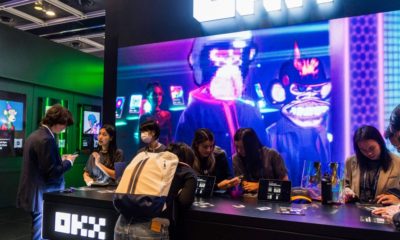Politics
A Match Made in Tech Heaven: Understanding the Relationship Between Blockchain and AI
Published
1 year agoon
By
Drew Simpson
In recent years, both blockchain and artificial intelligence (AI) have emerged as major disruptive technologies, revolutionizing industries and transforming the way we live and work. While blockchain is primarily known for its secure and transparent data storage capabilities, AI is renowned for its ability to analyze and learn from data, driving innovation and automation across sectors.
Despite their seemingly different functions, these two technologies have a lot in common and can be a powerful combination when integrated effectively. In this article, we will explore the relationship between blockchain and AI, their synergies, real-world applications, challenges, and future possibilities.
Blockchain and AI: A Primer
Blockchain and artificial intelligence (AI) are two of the most talked-about technologies of the 21st century, with the potential to transform industries and create new opportunities for innovation. However, while these technologies have a lot in common, they are fundamentally different in the way they function and the problems they can solve.
Understanding Blockchain Technology
Blockchain is a distributed ledger technology that allows multiple parties to store and share data in a secure and transparent way, without the need for intermediaries or centralized authorities. The concept of blockchain was first introduced in 2008, with the publication of a whitepaper titled “Bitcoin: A Peer-to-Peer Electronic Cash System” by an anonymous person or group known as Satoshi Nakamoto.
Key Characteristics of Blockchain
The key characteristics of blockchain include immutability, decentralization, and transparency. Immutability means that once data is added to the blockchain, it cannot be altered or deleted without the consensus of the network. Decentralization means that the blockchain is maintained by a network of nodes, rather than a single entity, making it resistant to attacks and failures. Transparency means that all transactions on the blockchain are visible to all participants, enabling greater accountability and trust.
Explanation of How Blockchain Works
Blockchain is like a digital notebook that records transactions and information across a network of computers. Each new transaction is verified by a group of computers called nodes, and recorded as a block in the notebook with a unique digital fingerprint based on the one before it. This fingerprint makes the notebook almost impossible to tamper with, ensuring the information inside is super secure. Because it’s decentralized, there’s no one person or organization that controls it, making it fairer and more transparent. The use of smart contracts allows for automated and secure transactions without intermediaries, with potential applications in industries from finance to healthcare to supply chain management.
Introduction to Artificial Intelligence
Artificial intelligence (AI) refers to the ability of machines to do tasks that normally need human intelligence, such as learning, problem-solving, and reasoning. It covers a wide range of fields, like machine learning, natural language processing, and robotics.
Key Characteristics of AI
The key characteristics of AI include the ability to analyze and learn from data, and to make predictions and recommendations based on that data. Machine learning, a subset of AI, involves the use of algorithms to automatically identify patterns in data and make predictions or decisions based on those patterns.
Explanation of How AI Works
AI works by processing large amounts of data using algorithms and neural networks, which are designed to mimic the way the human brain works. The data is used to train the algorithms, which then make predictions or decisions based on new data. Natural language processing (NLP), another subfield of AI, enables machines to understand and interpret human language, while robotics involves the use of machines to perform physical tasks.
Key Differences between Blockchain and AI
Differences in the way data is stored and processed
While blockchain is primarily designed for secure and transparent storage of data, AI is focused on the analysis and interpretation of data. Blockchain is a distributed ledger technology, while AI typically relies on centralized servers or cloud computing platforms.
Differences in the types of problems they can solve
Blockchain is particularly suited for applications where trust, security, and transparency are important, such as financial transactions, supply chain management, and voting systems. AI, on the other hand, is well-suited for tasks that require pattern recognition, prediction, and decision-making, such as fraud detection, recommendation systems, and autonomous vehicles.
Differences in the level of autonomy and decision-making capabilities
Another key difference between blockchain and AI is the level of autonomy and decision-making capabilities they offer. While blockchain is a passive technology that stores and verifies data without making decisions or taking actions on its own, AI is an active technology that can make decisions, take actions, and even learn and improve over time. This difference in autonomy and decision-making capabilities has significant implications for the types of applications that each technology can be used for, as well as the potential risks and challenges associated with their use.
Similarities between Blockchain and AI
While blockchain and AI have their differences, they also share some similarities that make them an attractive combination for certain applications. Here are some of the key similarities between these two technologies:
Both rely on data
Both blockchain and AI rely heavily on data to function effectively. In the case of blockchain, data is stored securely and transparently on a distributed ledger, while in the case of AI, data is used to train machine learning algorithms to recognize patterns and make predictions.
Both require computational power
Both blockchain and AI require significant computational power to function effectively. In the case of blockchain, this computational power is used to verify transactions and add new blocks to the chain, while in the case of AI, it is used to train machine learning models and make predictions based on large datasets.
Both offer decentralized solutions
Both blockchain and AI offer the potential for decentralized solutions that can reduce the need for intermediaries and increase trust and transparency. In the case of blockchain, this is achieved through a decentralized ledger that eliminates the need for a central authority to verify and store data. In the case of AI, decentralized solutions can be achieved through the use of decentralized machine learning algorithms that allow multiple parties to collaborate and train models without sharing their data.
Both are disruptive technologies
Both blockchain and AI are disruptive technologies that have the potential to transform industries and create new opportunities for innovation. By combining these two technologies, businesses and organizations can create new solutions that leverage the strengths of both and drive even greater disruption and transformation.
Synergies between Blockchain and AI
When blockchain and AI are combined, they can create powerful synergies that enable new solutions and capabilities. Here are some of the key areas where the combination of these two technologies can have a significant impact:
Enhanced security and privacy
Blockchain’s secure and transparent data storage capabilities can be combined with AI’s ability to analyze and make decisions based on data to create enhanced security and privacy solutions. For example, blockchain can be used to store and verify sensitive data, while AI can be used to analyze that data and make decisions about who should have access to it.
Improved supply chain management
By combining blockchain’s decentralized ledger with AI’s ability to analyze and make predictions based on data, businesses can create more efficient and transparent supply chain management solutions. For example, blockchain can be used to track the movement of goods and verify their authenticity, while AI can be used to analyze that data and predict when and where bottlenecks and delays are likely to occur.
Better fraud detection and prevention
The combination of blockchain and AI can also improve fraud detection and prevention by creating more secure and transparent data storage and analysis solutions. For example, blockchain can be used to store transaction data in a secure and transparent way, while AI can be used to analyze that data and detect patterns of fraudulent activity.
Enhanced healthcare solutions
By combining blockchain’s secure and transparent data storage capabilities with AI’s ability to analyze and learn from data, healthcare organizations can create new solutions that improve patient outcomes and reduce costs. For example, blockchain can be used to securely store patient health records, while AI can be used to analyze that data and make recommendations about treatment options.
Improved customer experiences
Finally, the combination of blockchain and AI can also improve customer experiences by creating more personalized and efficient solutions. For example, blockchain can be used to securely store customer data, while AI can be used to analyze that data and make personalized recommendations based on customers’ preferences and behavior.
Real-World Applications
The combination of blockchain and AI has the potential to revolutionize many industries and create new solutions and capabilities. Here are some of the real-world applications of this powerful combination:
Supply chain management
One of the most promising applications of blockchain and AI is in supply chain management. By combining blockchain’s decentralized ledger with AI’s ability to analyze and predict data, businesses can create more efficient and transparent supply chain management solutions. For example, companies can use blockchain to track the movement of goods and verify their authenticity, while AI can be used to analyze that data and predict when and where bottlenecks and delays are likely to occur.
Healthcare
Another promising application of blockchain and AI is in healthcare. By combining blockchain’s secure and transparent data storage capabilities with AI’s ability to analyze and learn from data, healthcare organizations can create new solutions that improve patient outcomes and reduce costs. For example, blockchain can be used to securely store patient health records, while AI can be used to analyze that data and make recommendations about treatment options.
Financial services
Blockchain and AI are also being used in financial services to create new solutions and capabilities. For example, blockchain can be used to create secure and transparent payment systems, while AI can be used to analyze transaction data and detect patterns of fraudulent activity.
Energy and utilities
The combination of blockchain and AI is also being used in the energy and utilities sector to create more efficient and sustainable solutions. For example, blockchain can be used to create decentralized energy grids, while AI can be used to analyze energy usage patterns and make predictions about future demand.
Identity management
Finally, blockchain and AI are being used in identity management to create more secure and transparent solutions. For example, blockchain can be used to securely store and verify identity data, while AI can be used to analyze that data and detect fraudulent activity.
Challenges and Limitations
While the combination of blockchain and AI holds great promise, there are also several challenges and limitations that must be overcome for these technologies to reach their full potential. Here are some of the key challenges and limitations:
Data quality and access
One of the main challenges of using AI with blockchain is ensuring the quality and accessibility of the data used to train machine learning models. Blockchain can help ensure the authenticity and security of the data, but if the data is incomplete or biased, it can lead to inaccurate or unfair predictions.
Scalability
Both blockchain and AI require significant computing power, and scaling these technologies can be challenging. Blockchain networks can become congested and slow as more transactions are added, while AI algorithms can become computationally expensive as the amount of data and complexity of the models increases.
Interoperability
There are currently many different blockchain platforms and AI tools available, and ensuring interoperability between these systems can be a challenge. Without standardization and interoperability, it can be difficult to create seamless and integrated solutions that can be easily adopted by businesses and organizations.
Regulation
As with any emerging technology, regulation can be a challenge. Blockchain and AI raise many legal and ethical questions around data privacy, ownership, and accountability. Without clear and consistent regulations, it can be difficult for businesses and organizations to adopt these technologies with confidence.
Adoption
Finally, one of the biggest challenges facing the combination of blockchain and AI is adoption. While there are many potential benefits to these technologies, many businesses and organizations are hesitant to invest in new and unproven technologies. As a result, widespread adoption of blockchain and AI solutions may take time.
Future Possibilities
Despite the challenges and limitations facing the combination of blockchain and AI, there are many exciting possibilities for the future of these technologies. Here are some potential areas of growth and innovation:
Decentralized AI
One potential area of growth is the development of decentralized AI systems that utilize blockchain technology to enable secure and transparent data sharing and analysis. This could enable more collaborative and open-source approaches to AI development, while also addressing issues of data privacy and ownership.
Smart Contracts
Another area of growth is the use of smart contracts to automate complex business processes and decision-making. By combining AI algorithms with smart contracts, it may be possible to create autonomous and self-executing systems that can operate independently of human intervention.
Supply Chain Management
Blockchain and AI could also be used to revolutionize supply chain management by creating more efficient and transparent systems for tracking and managing goods and materials. By utilizing blockchain’s immutable ledger and AI’s predictive capabilities, it may be possible to optimize supply chains and reduce waste and inefficiencies.
Personalized Healthcare
The combination of blockchain and AI could also have significant implications for personalized healthcare. By utilizing blockchain to securely store and share patient data, and AI to analyze that data and generate insights, it may be possible to develop more personalized and effective treatments for a wide range of conditions.
Digital Identity
Finally, blockchain and AI could be used to create more secure and trustworthy digital identity systems. By utilizing blockchain’s decentralized and tamper-proof ledger, and AI’s biometric and behavioral analysis capabilities, it may be possible to develop more robust and reliable digital identity solutions that can be used across a wide range of industries and applications.
Conclusion
The combination of blockchain and AI represents a powerful force for innovation and transformation across a wide range of industries and applications. While these technologies have their differences and challenges, they also share many similarities and offer exciting possibilities for collaboration and integration. From supply chain management to personalized healthcare and beyond, the potential applications of blockchain and AI are virtually limitless, offering the opportunity to create more secure, efficient, and innovative systems that can benefit us all. As these technologies continue to evolve and mature, it will be fascinating to see what new possibilities emerge and what impact they will have on our world.
Waqas Dogar
Waqas Dogar is an enthusiastic branding expert who loves helping businesses grow. He is passionate about utilizing the latest technologies and trends to create the most effective business strategies. With his expertise, he has been able to bring success to many companies, from small startups to multinationals.
You may like
-


Yahoo’s decades-long China controversy and the responsibility of tech companies
-


Chinese apps are letting public juries settle customer disputes
-


Make no mistake—AI is owned by Big Tech
-


Climate tech is back—and this time, it can’t afford to fail
-


Your guide to talking about climate tech over the holidays
-


Why Hong Kong is still bullish on crypto
Politics
Fintech Kennek raises $12.5M seed round to digitize lending
Published
7 months agoon
10/11/2023By
Drew Simpson
London-based fintech startup Kennek has raised $12.5 million in seed funding to expand its lending operating system.
According to an Oct. 10 tech.eu report, the round was led by HV Capital and included participation from Dutch Founders Fund, AlbionVC, FFVC, Plug & Play Ventures, and Syndicate One. Kennek offers software-as-a-service tools to help non-bank lenders streamline their operations using open banking, open finance, and payments.
The platform aims to automate time-consuming manual tasks and consolidate fragmented data to simplify lending. Xavier De Pauw, founder of Kennek said:
“Until kennek, lenders had to devote countless hours to menial operational tasks and deal with jumbled and hard-coded data – which makes every other part of lending a headache. As former lenders ourselves, we lived and breathed these frustrations, and built kennek to make them a thing of the past.”
The company said the latest funding round was oversubscribed and closed quickly despite the challenging fundraising environment. The new capital will be used to expand Kennek’s engineering team and strengthen its market position in the UK while exploring expansion into other European markets. Barbod Namini, Partner at lead investor HV Capital, commented on the investment:
“Kennek has developed an ambitious and genuinely unique proposition which we think can be the foundation of the entire alternative lending space. […] It is a complicated market and a solution that brings together all information and stakeholders onto a single platform is highly compelling for both lenders & the ecosystem as a whole.”
The fintech lending space has grown rapidly in recent years, but many lenders still rely on legacy systems and manual processes that limit efficiency and scalability. Kennek aims to leverage open banking and data integration to provide lenders with a more streamlined, automated lending experience.
The seed funding will allow the London-based startup to continue developing its platform and expanding its team to meet demand from non-bank lenders looking to digitize operations. Kennek’s focus on the UK and Europe also comes amid rising adoption of open banking and open finance in the regions.
Featured Image Credit: Photo from Kennek.io; Thank you!
Radek Zielinski
Radek Zielinski is an experienced technology and financial journalist with a passion for cybersecurity and futurology.
Politics
Fortune 500’s race for generative AI breakthroughs
Published
7 months agoon
10/11/2023By
Drew Simpson
As excitement around generative AI grows, Fortune 500 companies, including Goldman Sachs, are carefully examining the possible applications of this technology. A recent survey of U.S. executives indicated that 60% believe generative AI will substantially impact their businesses in the long term. However, they anticipate a one to two-year timeframe before implementing their initial solutions. This optimism stems from the potential of generative AI to revolutionize various aspects of businesses, from enhancing customer experiences to optimizing internal processes. In the short term, companies will likely focus on pilot projects and experimentation, gradually integrating generative AI into their operations as they witness its positive influence on efficiency and profitability.
Goldman Sachs’ Cautious Approach to Implementing Generative AI
In a recent interview, Goldman Sachs CIO Marco Argenti revealed that the firm has not yet implemented any generative AI use cases. Instead, the company focuses on experimentation and setting high standards before adopting the technology. Argenti recognized the desire for outcomes in areas like developer and operational efficiency but emphasized ensuring precision before putting experimental AI use cases into production.
According to Argenti, striking the right balance between driving innovation and maintaining accuracy is crucial for successfully integrating generative AI within the firm. Goldman Sachs intends to continue exploring this emerging technology’s potential benefits and applications while diligently assessing risks to ensure it meets the company’s stringent quality standards.
One possible application for Goldman Sachs is in software development, where the company has observed a 20-40% productivity increase during its trials. The goal is for 1,000 developers to utilize generative AI tools by year’s end. However, Argenti emphasized that a well-defined expectation of return on investment is necessary before fully integrating generative AI into production.
To achieve this, the company plans to implement a systematic and strategic approach to adopting generative AI, ensuring that it complements and enhances the skills of its developers. Additionally, Goldman Sachs intends to evaluate the long-term impact of generative AI on their software development processes and the overall quality of the applications being developed.
Goldman Sachs’ approach to AI implementation goes beyond merely executing models. The firm has created a platform encompassing technical, legal, and compliance assessments to filter out improper content and keep track of all interactions. This comprehensive system ensures seamless integration of artificial intelligence in operations while adhering to regulatory standards and maintaining client confidentiality. Moreover, the platform continuously improves and adapts its algorithms, allowing Goldman Sachs to stay at the forefront of technology and offer its clients the most efficient and secure services.
Featured Image Credit: Photo by Google DeepMind; Pexels; Thank you!
Deanna Ritchie
Managing Editor at ReadWrite
Deanna is the Managing Editor at ReadWrite. Previously she worked as the Editor in Chief for Startup Grind and has over 20+ years of experience in content management and content development.
Politics
UK seizes web3 opportunity simplifying crypto regulations
Published
7 months agoon
10/10/2023By
Drew Simpson
As Web3 companies increasingly consider leaving the United States due to regulatory ambiguity, the United Kingdom must simplify its cryptocurrency regulations to attract these businesses. The conservative think tank Policy Exchange recently released a report detailing ten suggestions for improving Web3 regulation in the country. Among the recommendations are reducing liability for token holders in decentralized autonomous organizations (DAOs) and encouraging the Financial Conduct Authority (FCA) to adopt alternative Know Your Customer (KYC) methodologies, such as digital identities and blockchain analytics tools. These suggestions aim to position the UK as a hub for Web3 innovation and attract blockchain-based businesses looking for a more conducive regulatory environment.
Streamlining Cryptocurrency Regulations for Innovation
To make it easier for emerging Web3 companies to navigate existing legal frameworks and contribute to the UK’s digital economy growth, the government must streamline cryptocurrency regulations and adopt forward-looking approaches. By making the regulatory landscape clear and straightforward, the UK can create an environment that fosters innovation, growth, and competitiveness in the global fintech industry.
The Policy Exchange report also recommends not weakening self-hosted wallets or treating proof-of-stake (PoS) services as financial services. This approach aims to protect the fundamental principles of decentralization and user autonomy while strongly emphasizing security and regulatory compliance. By doing so, the UK can nurture an environment that encourages innovation and the continued growth of blockchain technology.
Despite recent strict measures by UK authorities, such as His Majesty’s Treasury and the FCA, toward the digital assets sector, the proposed changes in the Policy Exchange report strive to make the UK a more attractive location for Web3 enterprises. By adopting these suggestions, the UK can demonstrate its commitment to fostering innovation in the rapidly evolving blockchain and cryptocurrency industries while ensuring a robust and transparent regulatory environment.
The ongoing uncertainty surrounding cryptocurrency regulations in various countries has prompted Web3 companies to explore alternative jurisdictions with more precise legal frameworks. As the United States grapples with regulatory ambiguity, the United Kingdom can position itself as a hub for Web3 innovation by simplifying and streamlining its cryptocurrency regulations.
Featured Image Credit: Photo by Jonathan Borba; Pexels; Thank you!
Deanna Ritchie
Managing Editor at ReadWrite
Deanna is the Managing Editor at ReadWrite. Previously she worked as the Editor in Chief for Startup Grind and has over 20+ years of experience in content management and content development.
